15 Easy Perennial Vegetables | Harvest for years
Perennial vegetables should be more popular. Most of them are easy to grow and not terribly fussy or difficult to accommodate in the garden. Once established, these tasty vegetables will provide you with food year after year. Plant once and harvest for years – what’s not to love?
Some perennial vegetables can be grown in place of their annual counterparts, for others there is no annual equivalent. If you enjoy the process of growing from seeds each year, then it makes sense to stick with that system and make space for the plants where only perennials will do. You may find that you prefer the taste of certain perennials, in which case, you can save yourself a whole load of work each year!
Articles on this site may contain affiliate links. As an Amazon Affiliate, we earn from qualifying purchases. Find our full Disclosure Policy here.
Globe Artichokes
Globe artichoke plants are tall and wide. They require plenty of space, however they do make great statement plants in both the vegetable and flower garden. Easy to grow from seed, transfer young plants once the risk of frost is past. Water well to ensure that the soil makes contact with the roots to give them a good start. Mulch around the young plants to conserve moisture. Mulching globe artichokes in late autumn can be helpful to protect plants from frost damage during the coldest part of the year.

Harvest globe artichokes
Harvest the immature flower heads before they get too large. The smaller artichokes are more tender.
Asparagus
Asparagus can be grown from seed, but it is usually quicker and easier to buy 2 year old crowns. When planting asparagus crowns, support the roots by making a mini-mountain or hill, spread out roots, ensuring the crown touches the soil, cover with compost or soil and water well to settle the soil around the roots. Asparagus prefers free draining soil, so if your garden has heavy, waterlogged soil, try growing in a raised bed to aid drainage. Asparagus is a long term investment, but once established, it provides a harvest for 20-30 years.

Harvest Asparagus
Do not harvest from newly planted crowns. It is worth waiting a year or two before starting to harvest to allow the plant to grow a strong root system and establish itself in the asparagus bed. Harvest this perennial vegetable in late spring. Once the shoots appear about 15-20 cms (6-8 inches) above the soil, use a knife to cut the spears. Do this by pushing the knife into the soil and cutting at an angle to remove the spear.
Each year leave some spears to grow to full size. Asparagus ferns do not create a huge amount of shadow on the ground around them, so can be interplanted with another crop like strawberries.
Chinese Artichoke
Chinese artichoke are harvested for their long, thin, knobbly tubers. They have a crunchy texture with nutty taste similar to water chestnuts.
Babbington Leek
A perennial form of leek. Cut stem to harvest and leave root and bulbous part to grow on. They have a mild hint of garlic and are cooked in the same way as annual leeks. Harvest during the hungry gap, early spring to early summer. Propagate from bulbils that grow on top of flower heads and around the bulbous base of the stem..
Caucasian Spinach
This is a climbing spinach, Hablitzia Tamenoides, another plant for the hungry gap, grows up to 3 metres. Grows readily from seed.
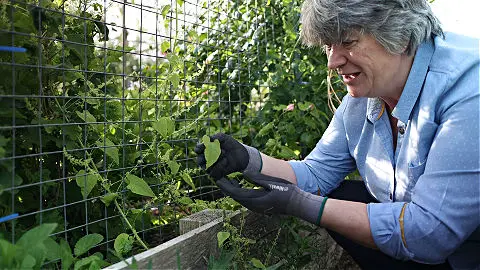
Jerusalem Artichoke
Jerusalem artichokes can be a bit of a thug in the garden, they regrow from any part of a tuber that is left in the ground after harvesting. So be careful about where you choose to plant them! Grow in a pot or tub is space in your garden is limited. Grows to a height of 6ft or more with sunflower like flowers. It can be grown as a screen, although may the stems might break in very windy conditions.
Rhubarb
Although rhubarb is usually eaten as a dessert, it is one of the easiest perennial vegetables to grow. Rhubarb can be grown from seed, however when you buy a rhubarb crown, harvesting can start much sooner. When you plant rhubarb, don’t bury too deep, leave the crown at or just above soil level. Do not harvest the first year after planting a crown to allow the roots to establish and the leaves to provide as much food as possible for the new plant.
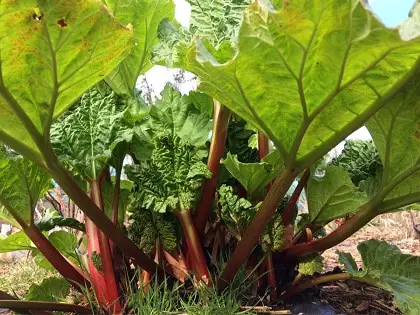
Harvest Rhubarb
To harvest rhubarb stems for the kitchen, pull the stems away from the crown rather than cutting them. This will reduce the risk of infection getting into the plant. Cut off and dispose of rhubarb leaves. Make sure you wash your hands after handling the leaves as they are poisonous.
Yacon
Related to Jerusalem artichoke, this tender perennial comes from Peru. They have delightful small yellow flowers, which look equally good in the flower garden as in the vegetable patch. Eat the bulbous tuber and use the rhizome for next year’s plants.
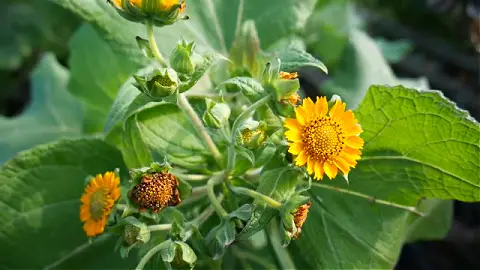
Harvest Yacon
Wait until the leaves have been blackened by the frost. This is the point at which the tubers start forming underground. Once the tubers have formed, dig up the tubers and rhizomes. Store the rhizomes in a frost free environment for the winter, for planting the next spring.
Skirret
As with many plants, skirret has gone in and out of fashion over the years. Recently a resurgence in interest in perennial vegetables has increased interest in and the popularity of skirret. Grown for its creamy white, long thin roots, it’s an attractive plant in the garden with delicate white flowers.
Oca
One of several perennial vegetables from the Andes, these small, colorful knobbly tubers are a good alternative to potatoes. Unlike potatoes, they can be eaten raw, grated into salads is ideal, they have a slightly lemony taste.
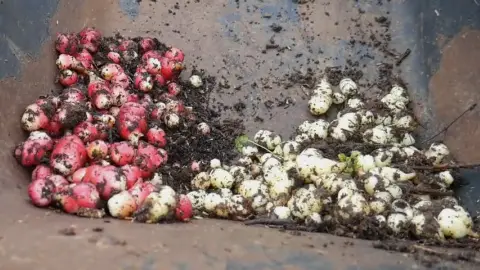
Harvest Oca
Harvest oca after the leaves have died back, but before very heavy and prolonged frosts. Leave some tubers in the ground for next year’s crop.
Taunton Deane Kale
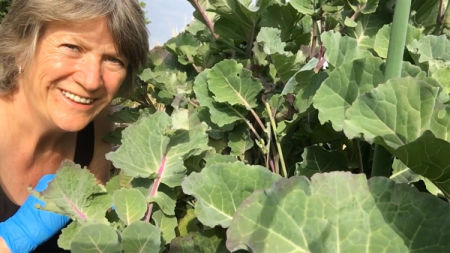
This perennial vegetable is easy to grow from cuttings, even in cooler weather. Taunton Deane kale can grow over two metres in each direction and is often less troubled by caterpillars than many annual brassicas. Harvest by picking a few leaves as required.
Nine Star Broccoli
Producing creamy white florets in spring, this hardy perennial can be kept from one year to the next by harvesting all the florets each year. You will also need to remove any flowers to prevent the plant going to seed. It produces masses of tasty florets and increases the yield year after year. Great for a multitude of uses in the kitchen, from using as a simple side dish to soups, stir-fry and tempura vegetable dippers.
Walking Stick Cabbage
These tall leafy plants grow vertically and produce leaves with a strong cabbage taste. Also known as cow cabbages as the taste is often preferred more by animals than humans. They can grow up to 3.5 metres (12 feet) tall.
Wild Garlic
Do not dig up from the wild. Buy it from a reputable seller. It will spread quickly in your garden to form a large clump. Good for a shady corner. Use the leaves in spring to make a pesto and to add to soups, stews and stir-fry dishes.
Egyptian Walking Onions
A clump forming onion that propagates itself by producing bulbils on the top of the stems. When the stem tops become too heavy, they bend over and the bulbils root in the soil. Hence, they seem to walk across the soil. Use the green stems in place of mild onions in your cooking. These perennial vegetables are a useful addition to the kitchen garden because the leaves are usually available earlier than the main onion crop.
- Autumn Groundcover - December 19, 2025
- Beautiful Bog Garden Plants - December 5, 2025
- Climbing plants for small gardens - November 21, 2025

Thank you the article Liz
Why do you say “Do not dig up from the wild.”?
Regards
Colin
Appreciate I’m responding to an old post, but thought it may be helpful to others. It’s illegal to dig up wild plants in the UK, unless given permission by the landowner. Even with permission it should be done with care – don’t take too many (so as not to deplete the local wild stock), and be careful where you replant as invasive plants can affect other wild flowers or insect life in the “wrong” area.
It’s illegal in the uk to dig up in the wild you are allowed to pick leaves and flowers but if you want the bulbs you can buy seeds online
Where can these perennials be sourced in US?
I’m going to ask a friend in USA to try to find sources for them online and then I can add links to this article.
Thank you for a very interesting article .
Do you sell any of these items that could be posted to me in Welney , Norfolk as I am interested in purchasing Oca… Taunton Dean kkale and the nine star broccoli.
Many thanks
Gilly Mooney
Hi Gilly, I haven’t sourced any nine star broccoli yet, but I’m hoping to get some this week. For a good start with perennials, try Incredible Vegetables and Backyard Larder.
great article Liz!
I am growing asparagus from seed which I started a month or so now but when should I plant out and is it possible to plant in a poly tunnel?